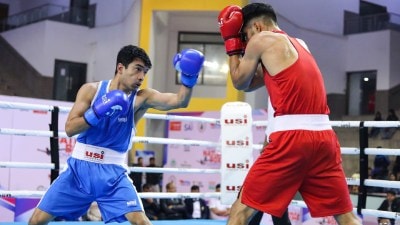State of turmoil
As politics becomes more volatile at the Centre, we may need to keep an eye on Maharashtra. Here8217;s why

Amid the continuing speculation about a mid-term poll at the Centre, one thing is certain: a state that is bound to experience the most political turmoil is Maharashtra. Incidentally, assembly polls are due here 8212; alongwith Lok Sabha polls, if they are held on schedule 8212; in 2009.
Ever since the Vilasrao Deshmukh government assumed office in the state in 2004, discontent simmers among the partners of the secular alliance, the Congress and NCP, as well as in the saffron alliance, the Shiv Sena and BJP.
The Congress and NCP may be partners in the Democratic Front DF government, but they are also rivals for the same votebank. In the 2004 assembly polls, the NCP emerged as the single-largest party with 71 members; the Congress won 68 in the House of 288. It took over a month8217;s deliberations for them to form the government. The Congress got the chief minister8217;s chair, while the NCP got more ministerial berths and important portfolios. But the 8216;secular8217; allies could not arrive at a consensus on sharing political appointments 8212; of special executive officers, official committees from the district-level upwards, and state-run corporations. Those issues still lie under the carpet, where they were swept in 2004.
About two years ago, Narayan Rane 8212; then a trusted aide of Sena chief Bal Thackeray 8212; raised the flag of revolt against Thackeray8217;s son and executive president of the party, Uddhav. Rane quit as Sena leader and was sacked. He got re-elected on a Congress ticket. He also engineered defections of seven Sena MLAs, out of which six got re-elected on Congress tickets, increasing the Congress numbers to 75, thereby upstaging the NCP as No 1. Being the chief minister in 1999 during Sena-BJP rule, Rane is considered a threat to Deshmukh and is cheered on by the anti-Deshmukh camp led by Maharashtra Pradesh Congress Committee chief Prabha Rau and AICC in-charge of the state, Margaret Alva.
The NCP, on the other hand, has armtwisted the Congress on various occasions. It defeated the Congress nominee for Rajya Sabha Avinash Pande by supporting independent industrialist Rahul Bajaj, backed by the Sena. Likewise, the NCP wrested power from the Congress in the Pune municipal corporation with Sena support. The NCP has a strong base in rural Maharashtra where rich Marathas run their fiefdoms through cooperatives. The NCP has already gone into poll mode. It has even floated a new outfit 8212; the Dalit, Muslim, OBC Manch to consolidate its position among the minorities.
One of the major setbacks to Sharad Pawar8217;s dreams of becoming prime minister was the election of Pratibha Patil as president. Though the party supported Patil, the NCP is annoyed at what could be a side-effect of that choice: the president and prime minister have never been from the same state.
The tension between the Sena and BJP has also been building up. There has been friction on several occasions 8212; like the Chimur assembly bypoll 8212; where the Sena MLA had quit, joining the Congress, and the BJP wanted to contest the seat. When differences between BJP8217;s state chief and Uddhav Thackeray reached a flashpoint, Thackeray Sr intervened and let the BJP contest, and lose.
The presidential poll boosted the tension as the Sena supported Patil. The latest rift was evident in the poll for the legislative council from the Aurangabad-Jalna local bodies. The BJP refused to support Sena8217;s nominee and supported an independent.
The BJP has not been able to fill the void left by Pramod Mahajan. There is a strong feeling among the BJP leaders that the Sena has taken them for granted.
The saffron partners have been at loggerheads over issues like SEZs. As an opposition party, the Sena has always targetted the Congress more than the NCP. The Sena supported Pawar8217;s daughter, Supriya Sule, for Rajya Sabha, for instance.
So, with the possibility of a snap poll on the horizon, the Sena is uncomfortable with its ally of 22 years, the BJP, and a similar discomfort is to be found in the secular alliance on the other side. The demand to take action on the recommendations of the Srikrishna Commission has only stoked these tensions further.
The moment may be ripe, in the foreseeable future, for a re-alignment in the secular and saffron camps. Will the Sena and NCP 8212; parties that have much in common, including their leadership pattern and their views on Sonia8217;s nationality, besides Pawar8217;s friendship with Thackeray 8212; come together formally? Will the BJP seek the support of Raj8217;s Maharashtra Navnirman Sena MNS, in case its alliance with the Shiv Sena breaks?
- 01
- 02
- 03
- 04
- 05































